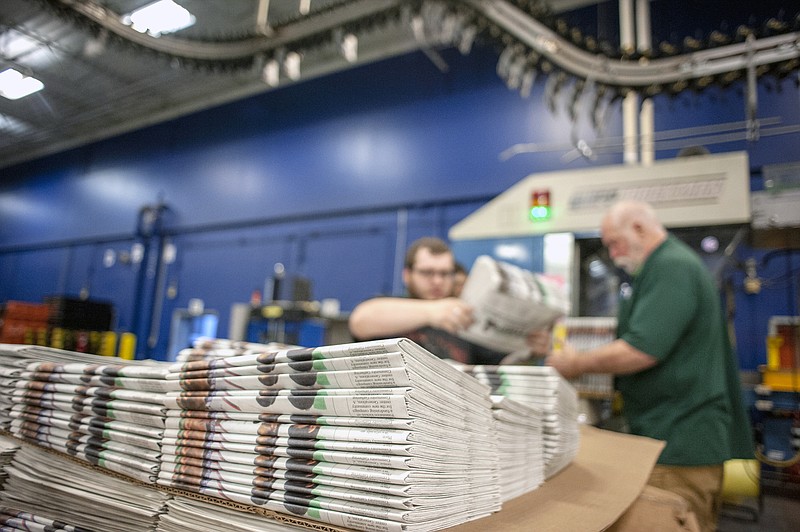The Trump administration's decision to impose tariffs on Canadian newsprint is hastening the demise of local newspapers across the country, forcing already struggling publications to cut staff, reduce the number of days they print and, in at least one case, shutter entirely.
Surging newsprint costs are beginning to hurt publications like The Gazette in Janesville, Wisconsin, the hometown paper of the House speaker, Paul Ryan, which has long felt a mandate to punch above its weight. The paper, with a newsroom staff of 22, was the first to publish the news in 2016 that Ryan would support the presidential candidacy of Donald Trump. And while its editorial board has endorsed Ryan countless times, the paper made national news when it chided him for refusing to hold town halls with his constituents.
Now, with newsprint tariffs increasing annual printing costs by $740,000, The Gazette has made several cuts to its staff and is using narrower paper, reducing the number of stories published every day.
"We're all paying a huge price," Skip Bliss, publisher of The Gazette, said of the tariffs' effect on the industry. "I fear it's going to be a very difficult time. I think there's probably going to be some casualties."
The newsprint tariffs are just one of several trade measures Trump has rolled out as part of his administration's effort to protect U.S. manufacturers by stopping what he calls unfair trade practices. Tariffs were implemented in January, after the Commerce Department sided with North Pacific Paper Co., a paper mill based in Washington state, in a complaint alleging that Canadian manufacturers were selling newsprint at artificially low prices. Last week, publishers won a small reprieve when the agency said it would cap the anti-dumping tariffs at 16.88 percent, down from 22 percent and apply them to a single manufacturer, Catalyst Paper Co. But Commerce said it would also impose tariffs of up to 9.81 percent on several Canadian paper companies, including Catalyst, to counter subsidies that those manufacturers receive from the government.
Catalyst, which had been exporting more than 425,000 metric tons of newsprint into the United States before the levies went into effect, will face total tariffs of more than 20 percent.
Even if the tariffs seem to align with Trump's well-known disdain for the news media, the administration's ruling in favor of the company that filed the complaint was not unusual as the president carries out his trade fight.
The administration has encouraged companies to bring cases when they have complaints against foreign parties, and the "countervailing duty" process under which North Pacific Paper's case was initiated is set up to defend U.S. companies against foreign competitors. As of mid-July, companies had brought 120 new anti-dumping and countervailing duty investigations under the Trump administration - about a third more than in a similar time frame at the end of the Obama administration, according to Commerce Department statistics.
As with Trump's other tariffs on steel, aluminum, solar panels and washing machines, the newsprint duties will help some U.S. manufacturers but hurt many other domestic companies.
A Charles River Associates study undertaken on behalf of a coalition of printers, publishers and paper suppliers projects that U.S. newsprint prices will increase more than 30 percent in the next one to two years, and that newspapers and printers will face an increased cost of roughly half a billion dollars from the remaining five U.S. mills producing newsprint. The study was filed with the U.S. International Trade Commission, an independent federal agency that governs trade and could ultimately overturn or change the Commerce Department's decision in a ruling expected next month.
Papers throughout the country are already feeling the effects of the tariffs. At least a dozen newspapers across the country have cut publication days, and one newspaper, The Jackson County Times-Journal in Ohio, shut down, citing declining print readership and the tariffs. Larger publications, like The Tampa Bay Times, which won two Pulitzer Prizes in 2016 for local and investigative reporting, are also on the list of affected papers.
Paul Tash, chairman and chief executive of The Tampa Bay Times, said the price per ton of paper had increased $200, creating an additional $3.5 million in printing expenses annually. Tash said that as a direct result of the tariffs, he had to lay off 50 employees, combine sections in the Sunday paper and reduce the frequency of a free tabloid from five days to once a week.
In some rural towns, the local weekly newspaper serves as the area's only media outlet, said Crystal Dupre, publisher of The Bryan-College Station Eagle in Bryan, Texas.
"There is no question that without a local newspaper, no one is holding officials accountable and serving as the local archives," Dupre said.
In response to printing cost increases of 30 percent, she said, The Eagle has reduced the number of pages it prints daily, and avoided filling vacant positions in "every single department," from editorial to accounting. Dupre said she has tried to avoid cutting reporting positions, instead asking other departments to take on more work.
